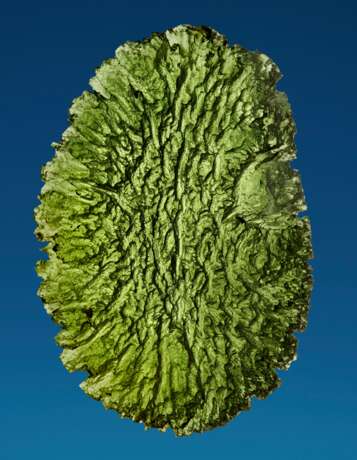ID 389980
Lot 37 | MOLDAVITE — WHEN EARTH AND ASTEROID COLLIDE AND CREATE GLASS
Valeur estimée
$ 2 500 – 3 500
A tektite’s shape is largely the result of aerodynamics. Apart from the material itself, the shape is a product of a host of variables including the altitude that an asteroid impact splashes molten material into the sky, the subsequent ablation during its return to Earth, its degree of orientation and speed of rotation. Surface detail is largely the result of the acidity of the soil in which the glass remained entombed for millions of years. Now offered is a highly crenelated, deep green, moldavite disk from the prized location of Nesmin in the Czech Republic.
47 x 29 x 12mm (2 x 1 x 0.5 in.)
30.57g
When an asteroid impact melts the Earth. While the result of the crushing, destructive force of an asteroid impact is revealed in lot 31, at times a dramatically different type of impact product is formed. Tektites are silicate-glass formations whose origin was long considered a mystery. Today, however, scientists agree that these objects, whose name comes from the Greek tektos (“melted”), form after an asteroid slams into Earth.
The extraordinary heat and pressure resulting from such an apocalyptic event not only shatters the target rock, but actually liquifies it and splashes the molten rock into the atmosphere from where it returns to Earth as solidified glass. The type of glass, color, and opacity depend on the type of material liquefied.
Tektites are terrestrial in origin and are named after the locality in which they are found. Hence, there are philippinites, australites and moldavites — indisputably the most beautiful of all. Moldavite was formed nearly 15 million years ago by the asteroid impact that created the 14.5 mile diameter Nördlinger-Ries crater near Stuttgart, Germany and is found in the Moldau River Valley in the Czech Republic nearly 450 km (280 miles) away from the site of impact. Revered as a talisman by Paleolithic humans and delivered by men to their fiancées in the 17th-19th centuries to assure harmony in marital relations, moldavite is often cut into gemstones. Prized for its clarity, shape and color, moldavite’s surface texture is substantially determined by the chemistry of the soil in which it landed: a hill across a road can provide a markedly different-looking sample than one found in an adjacent valley. Crenellations abound in this superior example found outside the town of Nesmin — which is renowned for its moldavite. The hues, which range from emerald to tourmaline, result from variations of density in this sublime natural impact glass.
Christie's would like to thank Dr. Alan E. Rubin at the Institute of Geophysics and Planetary Physics, University of California, Los Angeles for his assistance in preparing this catalogue.
| Adresse de l'enchère |
CHRISTIE'S 8 King Street, St. James's SW1Y 6QT London Royaume-Uni | |
|---|---|---|
| Aperçu |
| |
| Téléphone | +44 (0)20 7839 9060 | |
| Commission | see on Website | |
| Conditions d'utilisation | Conditions d'utilisation |



